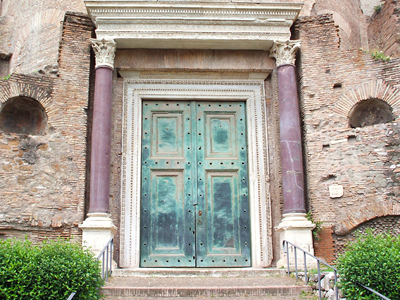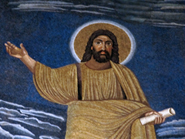SUN AN’ SOUL - DREAM AN’ ROME
TEMPLE OF ROMULUS AND BASILICA OF SAINTS COSMAS AND DAMIAN
 |
| Temple of Romulus - click to enlarge |
On the Via Sacra (=sacred street), well-preserved, faces the Temple of the deified Romulus, not the mythical king of Rome, but Valerius Romulus son of emperor Maxentius, who died very young and was deified.
The temple has a central circular body, covered by a dome which was lined with white marble. The lantern you see above the dome was made during the Baroque period. In the concave façade, before the circular body, open to the left and to the right of the entrance 4 niches that housed as many statues.
At the sides of the central body there are two rooms ending each with an apse and preceded by a pair of marble columns, placed on high bases (only those on the right have survived).
On either side of the entrance portal you see two columns of porphyry, the marble of the emperors, with white Corinthian capitals, which support a rich trabeation also of white marble.
The bronze door is the original one and it seems that the lock still functions.
 |
| Temple of Romulus, the entrance portal - click to enlarge |
The temple was built in place of a circular entrance leading to the Forum of Vespasian, also known as the Forum of Peace, from the Via Sacra.
In 527 Theodoric, king of the Goths, the people coming from the east Christianized Europe, when he took control of Rome donated to Pope Felix IV the Temple of Romulus and the library of the Temple of Peace, soon turned in the church of Saints Cosmas and Damian, and the two buildings, temple and church, were connected.
Inside the temple today are placed the statues of the Dioscuri group coming from nearby Fonte (=fountain) Juturna.
The Basilica of Saints Cosmas and Damian, with its monastery, is located inside the Temple of Peace, built by Vespasian to celebrate the victory over the Jews and the conquest of Jerusalem in 70 AD.
 |
| Basilica of Saints Cosmas and Damian - click to enlarge |
Within the Temple were kept the sacred ritual objects of the Temple of Jerusalem, including the seven-branched candlestick, as carved in near arch of Titus.
The Temple was destroyed by fire at the time of Commodus (about 190) and rebuilt shortly afterwards by Septimius Severus, who on a wall made to affix the marble slabs of the Forma Urbis, that precisely describe the shape of the city in the imperial era.
Many centuries later Pope Urban VIII Barberini restored the basilica, raising the floor of 7 meters, the church turned out thus formed by two environments, the lower at the level of the Roman Forum.
In 1947 the lower entrance, which passed through the Temple of Romulus, was closed and simultaneously was restored the Temple of Romulus. Closed the old entrance was opened a new one on Via dei Fori Imperiali.
The interior features the spectacular mosaic in the apse, one of the most beautiful of Christian Rome, remarkable for its expressiveness, coloring and liveliness. The mosaic dates back to the time of Pope Felix IV (526 – 530), who here is depicted holding a model of the church.
This mosaic is considered the last masterpiece of ancient Roman art before the advent of the Byzantine style.
The scene, standing out against the blue cobalt background, shows Cosmas and Damian who accompanied by St. Paul (left) and St. Pietro go towards Christ pointing to the sky.
In the lower section the twelve sheeps represent the apostles.
| Basilica of Saints Cosmas and Damian, the mosaic in the apse - click to enlarge |
 |
 |
 |
 |
| St. Paul |
St. Pietro |
Christ |
The apostles |
The artist through the strong color contrasts and the intense characterization of the faces, creates a representation of the most lives and engaging of all Christian art mosaic.
The mosaics that decorate the arch of the apse are successive, installed at the time of Pope
Sergius I (650-701). The gold background and the accentuated symbolic abstraction highlight the achievement of the Byzantine style.
back |

